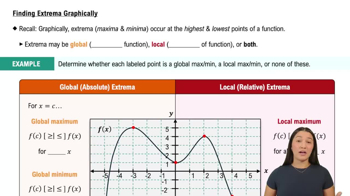Table of contents
- 0. Functions7h 52m
- Introduction to Functions16m
- Piecewise Functions10m
- Properties of Functions9m
- Common Functions1h 8m
- Transformations5m
- Combining Functions27m
- Exponent rules32m
- Exponential Functions28m
- Logarithmic Functions24m
- Properties of Logarithms34m
- Exponential & Logarithmic Equations35m
- Introduction to Trigonometric Functions38m
- Graphs of Trigonometric Functions44m
- Trigonometric Identities47m
- Inverse Trigonometric Functions48m
- 1. Limits and Continuity2h 2m
- 2. Intro to Derivatives1h 33m
- 3. Techniques of Differentiation3h 18m
- 4. Applications of Derivatives2h 38m
- 5. Graphical Applications of Derivatives6h 2m
- 6. Derivatives of Inverse, Exponential, & Logarithmic Functions2h 37m
- 7. Antiderivatives & Indefinite Integrals1h 26m
- 8. Definite Integrals3h 25m
5. Graphical Applications of Derivatives
Intro to Extrema
Problem 4.1.37
Textbook Question
Locating critical points Find the critical points of the following functions. Assume a is a nonzero constant.
ƒ(x) = x² √(x + 5)
 Verified step by step guidance
Verified step by step guidance1
First, find the derivative of the function ƒ(x) = x² √(x + 5) using the product rule and the chain rule.
Set the derivative equal to zero to find the critical points, as critical points occur where the derivative is zero or undefined.
Solve the equation obtained from setting the derivative to zero for x to find potential critical points.
Check the domain of the original function to ensure that the critical points found are valid within the context of the function.
Evaluate the behavior of the function around the critical points to determine if they are local maxima, minima, or points of inflection.
Was this helpful?

 5:58m
5:58mWatch next
Master Finding Extrema Graphically with a bite sized video explanation from Callie
Start learning





